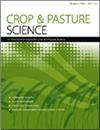大豆(Glycine max)超早熟、高产及抗绿豆黄花叶印度病毒(MYMIV)改良基因型的研制
IF 1.9
4区 农林科学
Q2 AGRICULTURE, MULTIDISCIPLINARY
引用次数: 1
摘要
本文章由计算机程序翻译,如有差异,请以英文原文为准。
Development of improved genotypes for extra early maturity, higher yield and Mungbean Yellow Mosaic India Virus (MYMIV) resistance in soybean (Glycine max)
ABSTRACT Context. Breeding for early maturity and higher yield is the principal objective in genetic improvement of Indian soybean. Yellow Mosaic Disease caused by Mungbean Yellow Mosaic India Virus (MYMIV) causes 80% yield loss in soybean. Aims. This study aimed to develop early maturing, MYMIV resistant and high yielding soybean genotypes for enhancing soybean production and expanding the land area under cropping. Methods. MYMIV resistance was introgressed from G. soja in to a widely adaptable cultivar JS 335 through a series of four generations of backcrosses and by evaluating derived progeny against MYMIV at a disease hot spot. Key results. An extra-early maturing (71 days) genetic stock called NRC 252 was developed, which can be a potential gene donor in breeding for early maturing soybean varieties. Introgression lines YMV 1, YMV 2, YMV 11 and YMV 16 with MYMIV resistance and higher yield performance over recurrent parent and other check varieties were identified and characterised. Biplot analysis, assessing the main effect of genotype and the interaction of genotype with environment, revealed an ideal genotype with respect to 100-seed weight and grain yield that was also promising under sugarcane-soybean intercropping system in spring season. Conclusions. Alleles from wild type soybean could improve yield attributing traits and MYMIV resistance in cultivated soybean. Improved genotypes such as YMV 1, YMV 2, YMV 11 and YMV 16 were found superior to the recurrent parent JS 335 as well as other check varieties. Implications. The genotypes developed in the present study will help in reducing the damage caused by MYMIV disease and expansion of the area of soybean cultivation through intercropping with sugarcane.
求助全文
通过发布文献求助,成功后即可免费获取论文全文。
去求助
来源期刊

Crop & Pasture Science
AGRICULTURE, MULTIDISCIPLINARY-
CiteScore
4.20
自引率
15.80%
发文量
111
审稿时长
3 months
期刊介绍:
Crop and Pasture Science (formerly known as Australian Journal of Agricultural Research) is an international journal publishing outcomes of strategic research in crop and pasture sciences and the sustainability of farming systems. The primary focus is broad-scale cereals, grain legumes, oilseeds and pastures. Articles are encouraged that advance understanding in plant-based agricultural systems through the use of well-defined and original aims designed to test a hypothesis, innovative and rigorous experimental design, and strong interpretation. The journal embraces experimental approaches from molecular level to whole systems, and the research must present novel findings and progress the science of agriculture.
Crop and Pasture Science is read by agricultural scientists and plant biologists, industry, administrators, policy-makers, and others with an interest in the challenges and opportunities facing world agricultural production.
Crop and Pasture Science is published with the endorsement of the Commonwealth Scientific and Industrial Research Organisation (CSIRO) and the Australian Academy of Science.
 求助内容:
求助内容: 应助结果提醒方式:
应助结果提醒方式:


